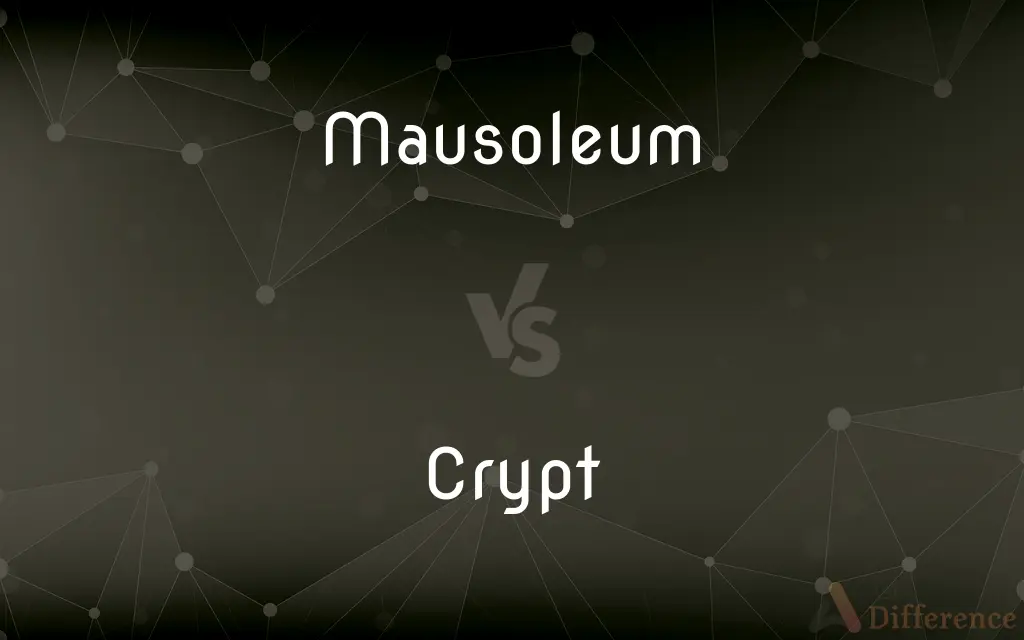Mausoleum vs. Crypt — What's the Difference?
By Tayyaba Rehman & Maham Liaqat — Updated on March 8, 2024
A mausoleum is a freestanding above-ground tomb, often elaborate and designed for the deceased elite, while a crypt is an underground room or vault beneath a church, used as a burial place.

Difference Between Mausoleum and Crypt
Table of Contents
ADVERTISEMENT
Key Differences
Mausoleums are grand, above-ground structures built as memorials for the gone, often seen in cemeteries and memorial parks. They are designed to house the remains of individuals or families and can be quite elaborate. On the other hand, crypts are typically found below churches or other religious buildings, serving as burial sites. Crypts are more enclosed and can be simpler in structure, focusing on solemnity and reverence.
While mausoleums can be accessible to the public, showcasing architectural beauty and the status of those interred within, crypts are usually more private, part of the church's fabric, and less visible to the general public. This difference reflects the mausoleum's role in commemorating the deceased's life and achievements, whereas crypts often emphasize spiritual rest and continuity with the church community.
Mausoleums allow for individual or family memorials, with separate chambers or niches for coffins or urns, allowing for personalized commemorations. Crypts, however, often contain multiple burial sites within a confined space, with less emphasis on individual memorialization and more on collective memory and unity in gone.
In terms of construction, mausoleums require significant above-ground space and resources, making them symbols of wealth and status. Crypts, being underground, have a different set of architectural and engineering considerations, such as ventilation and moisture control, reflecting practical and spiritual considerations rather than status.
The choice between a mausoleum and a crypt can be influenced by cultural, religious, and personal preferences. Mausoleums might be preferred by those seeking a prominent memorial that stands out, while crypts might be chosen for their intimate connection to a place of worship and the communal aspect of burial.
ADVERTISEMENT
Comparison Chart
Location
Above ground
Underground
Visibility
Often public and visible
More private and hidden
Purpose
Memorialization and status display
Burial and religious significance
Structure
Freestanding building, elaborate
Underground vault or chamber, simpler
Personalization
High (individual or family chambers)
Lower (collective burial spaces)
Architectural Style
Varied, often elaborate and decorative
Often simpler, integrated with church architecture
Symbolism
Wealth, status, and remembrance
Spiritual rest, community, and continuity with the church
Accessibility
Can be visited by the public
Usually restricted to specific individuals or groups
Space Requirement
Requires significant land
Utilizes existing underground space
Construction Costs
Generally high due to materials and design complexity
Varies, often lower than mausoleums but depends on context
Compare with Definitions
Mausoleum
A large, stately tomb above ground.
The family visited the patriarch's mausoleum to pay their respects.
Crypt
A space for collective burial.
Families visited the crypt to honor ancestors buried together in the communal space.
Mausoleum
A structure reflecting wealth and status.
The elaborate mausoleum underscored the deceased's prominence in society.
Crypt
An underground burial vault, typically beneath a church.
The ancient crypt held the remains of the town's earliest settlers.
Mausoleum
A public or private memorial space.
Their private mausoleum was adorned with personal artifacts and memories.
Crypt
Part of church architecture and history.
The crypt, dating back centuries, was a significant part of the church's heritage.
Mausoleum
A building housing multiple tombs.
The historic mausoleum contained the remains of several notable figures.
Crypt
A site for spiritual reflection and mourning.
The dimly lit crypt offered a solemn space for contemplation.
Mausoleum
A mausoleum is an external free-standing building constructed as a monument enclosing the interment space or burial chamber of a deceased person or people. A mausoleum without the person's remains is called a cenotaph.
Crypt
A chamber for religious or ceremonial burial.
The crypt was used for the burial of priests and religious figures.
Mausoleum
A large stately tomb or a building housing such a tomb or several tombs.
Crypt
A crypt (from Latin crypta "vault") is a stone chamber beneath the floor of a church or other building. It typically contains coffins, sarcophagi, or religious relics.
Mausoleum
A gloomy, usually large room or building.
Crypt
An underground vault or chamber, especially one beneath a church that is used as a burial place.
Mausoleum
A large stately tomb or a building housing such a tomb or several tombs.
Crypt
(Anatomy) A small pit, recess, or glandular cavity in the body.
Mausoleum
(by extension) A gloomy, usually large room or building.
Crypt
A cave or cavern.
Mausoleum
A magnificent tomb, or stately sepulchral monument.
Crypt
An underground vault, especially one beneath a church that is used as a burial place.
Mausoleum
A large burial chamber, usually above ground
Crypt
(anatomy) A small pit or cavity in the surface of an organ or other structure.
Crypt
(botany) Any of the genus Cryptocoryne of aquatic plants of southern and southeastern Asia.
Crypt
(botany) Any of the genus Cryptopus of orchids of Madagascar and Mauritius.
Crypt
A vault wholly or partly under ground; especially, a vault under a church, whether used for burial purposes or for a subterranean chapel or oratory.
Priesthood works out its task age after age, . . . treasuring in convents and crypts the few fossils of antique learning.
My knees are bowed in crypt and shrine.
Crypt
A simple gland, glandular cavity, or tube; a follicle; as, the crypts of Lieberkühn, the simple tubular glands of the small intestines.
Crypt
A cellar or vault or underground burial chamber (especially beneath a church)
Common Curiosities
How do mausoleums differ from crypts?
Mausoleums are freestanding, above-ground structures, often public and visible, while crypts are underground and more integrated with religious buildings.
Who is buried in a crypt?
Crypts are used for the burial of church members, clergy, and sometimes the general public, emphasizing spiritual significance over status.
What is a crypt?
A crypt is an underground room or vault, typically beneath a church, used as a burial place.
Are crypts only for religious figures?
Not exclusively; crypts can also house the remains of community members and are often found beneath churches.
How are crypts built?
Crypts are built underground, often beneath churches, with considerations for ventilation and moisture control.
Can mausoleums hold multiple people?
Yes, mausoleums can be designed for individual or family use, with separate chambers or niches for each person.
What is a mausoleum?
A mausoleum is an above-ground structure designed for burial or memorial purposes, often elaborate and intended for the deceased elite.
Can anyone have a mausoleum?
While anyone can commission a mausoleum, they are typically associated with individuals or families that can afford the considerable expense.
What is the purpose of a mausoleum?
Mausoleums serve to memorialize the deceased, often showcasing wealth, status, and achievements.
What is the purpose of a crypt?
Crypts provide a burial space with religious significance, focusing on spiritual rest and community continuity.
Who is buried in a mausoleum?
Individuals or families, often those of wealth or status, choose mausoleums for their burial or memorialization.
What makes crypts different in terms of construction?
Crypts utilize existing underground space, often with simpler construction than mausoleums, focusing on practical and spiritual needs.
How are mausoleums built?
Mausoleums are constructed above ground, requiring significant space and resources, reflecting elaborate architectural designs.
Can crypts be visited by the public?
Access to crypts can vary; some are open to the public, while others are private or restricted to certain individuals.
Do mausoleums offer personalization?
Yes, mausoleums allow for a high degree of personalization, with spaces for individual or family memorials.
Share Your Discovery

Previous Comparison
Eurasian vs. Caucasian
Next Comparison
Foreground vs. BackgroundAuthor Spotlight
Written by
Tayyaba RehmanTayyaba Rehman is a distinguished writer, currently serving as a primary contributor to askdifference.com. As a researcher in semantics and etymology, Tayyaba's passion for the complexity of languages and their distinctions has found a perfect home on the platform. Tayyaba delves into the intricacies of language, distinguishing between commonly confused words and phrases, thereby providing clarity for readers worldwide.
Co-written by
Maham Liaqat













































